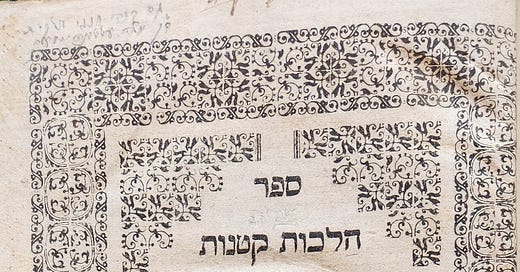Rabbi Yakov Chagiz
Rabbi Yakov Chagiz was born in Fez, Morocco in 1620. His father, Rabbi Shmuel Chagiz, was a prominent rabbi and darshan (lecturer) whose ancestors originated from Spain.
Around 1635, Rabbi Yakov Chagiz traveled to Italy (via Egypt, Salonica, and Constantinople) where he became a student (and eventually son-in-law) of Rabbi David Karigal. In 1645, at the young age of twenty-five, Rabbi Yakov Chagiz published his first work Ein Yisrael, an Aggadic commentary on Rabbi Yakov ibn Chaviv’s Ein Yakov. Two years later, in 1647, he published two more works: Orach Mishor (on ethics) and Techilas Chachmah (on Talmudic methodology). Just one year later, in 1648, Rabbi Chagiz published a small pamphlet titled Kitzur Dinei Krias Shema v’Tefillah. His remarkable commentary on the Mishnah, titled Eitz ha-Chayim was completed in 1656.
To the Holy Land: Opening Midrash Beis Yakov
Around 1658, the wealthy Vega brothers of Leghorn, Italy decided to establish a yeshiva in Jerusalem and selected Rabbi Yakov Chagiz as its dean. The yeshiva, called Midrash Beis Yakov after its leader Rabbi Yakov Chagiz, attracted many great Torah scholars.
Around this time, Rabbi Yakov Chagiz’s wife died and he remarried the daughter of Rabbi Moshe Galante. [Rabbi Galante, known as הרב המג״ן, should not be confused with his grandfather - Rabbi Moshe Galante the Elder, who was a student of Rabbi Yosef Karo in Tzfas]. From this marriage, Rabbi Yakov had three children: Rabbi Moshe Chagiz, and two daughters, one who married Rabbi Moshe ibn Chaviv, and the other who married Rabbi Chaim Mordechai Zabi.
The False Messiah Arrives in Jerusalem
In 1665, when Shabbetai Tzvi and his prophet Nathan of Gaza (Nathan had formerly been one of Rabbi Yakov Chagiz’s premier disciples) arrived in Jerusalem to proclaim the arrival of the messiah, Rabbi Yakov Chagiz and his colleagues (Rabbis Avraham Amigo, Yakov Semah, and Shmuel Gramizan) proclaimed a cherem (excommunicative ban) on the false messiah. In the coming months as Shabbetai and Nathan’s messianic movement captivated the hearts and souls of a large segment of the Diaspora, Rabbi Chagiz went to great lengths to sever his affiliation with his ex-student.
Additional works that Rabbi Yakov Chagiz wrote are: Korban Minchah, Pri Chadash, and Lechem ha-Panim.
In 1674, while visiting Italy to print his Lechem ha-Panim, Rabbi Yakov Chagiz suddenly passed away at the age of fifty-four.
Although Rabbi Yakov Chagiz arranged and edited his responsa for publication, he wasn’t able to print them during his lifetime. Rabbi Yakov Chagiz’s responsa, Halachos Ketanos (abbreviated ספר הלק״ט), on the four sections of Shulchan Aruch, were first printed in Venice by the author’s son, Rabbi Moshe Chagiz, in 1704.
Halachos Ketanos, Venice 1704
Rabbi Moshe Chagiz
Born in Jerusalem in 1671, Rabbi Moshe Chagiz (called המני״ח - הרב משה ן׳ יעקב חגיז) was a young boy of two when his father passed away. He was raised by his maternal grandfather, Rabbi Moshe Galante who, together with the grand Rabbi Avraham Yitzchaki, taught the young boy Torah. After his grandfather’s passing in 1689, Rabbi Moshe Chagiz traveled to Europe in an attempt to revitalize his father’s yeshiva Midrash Beis Yakov which had since closed its doors due to internal politics and a lack of funding. Ultimately, Rabbi Moshe Chagiz was unsuccessful at securing the necessary funds to reopen the yeshiva so he remained in Europe.
After spending some time in Venice, Rabbi Moshe Chagiz moved to Amsterdam where he befriended the preeminent Moravian rabbi and halachist, Rabbi Tzvi Hirsch Ashkenazi (known as the Chacham Tzvi). In 1714, Rabbis Ashkenazi and Chagiz detected the crypto-Sabbatean Nechemiah Chiyun and protested against his heretical work Oz L’Elohim. A fierce rabbinic controversy known as the Chiyun Affair ensued after Chiyun gained the support of the Sephardic rabbi of Amsterdam, Rabbi Shlomo Ayalon, who was himself a crypto-Sabbatean. Ultimately, both Rabbis Chagiz and Ashkenazi were forced out of Amsterdam.
Following the Chiyun Affair, Rabbi Moshe Chagiz settled in Hamburg, Germany where he served as a teacher and darshan.
In 1738, after nearly fifty years away from his native land, Rabbi Moshe Chagiz returned to Eretz Yisrael and settled in the holy city of Tzfas. According to the Chida, Rabbi Moshe Chagiz merited an exceedingly long life and died around the age of ninety in 1762.
The Prolific Writings of Rabbi Moshe Chagiz
Rabbi Moshe Chagiz wrote: 1) Leḳeṭ ha-Ḳemacḥ, a commentary on the Shulchan Aruch, 2) Leḳeṭ ha-Ḳemacḥ, a commentary on the Mishnah, 3) Sefas Emes on the religious significance of Eretz Yisrael, 4) Eyleh ha-Miẓvos on the 613 commandments, 5) Shever Posh'im, 6) Shoftim B’Aretz, 7) Melchamah L’Hashem v’Cherev L’Hashem, a series of polemics against Nechemiah Chiyun and other Sabbateans, 8) Perure Pas ha-Ḳemacḥ, a commentary to Sefer Daniel, 9) Tz’ror ha-Chaim on ethics, 10) Mishnas Chachamim on the forty-eight ways to acquire Torah, and 11) Shete ha-Lecḥem, a collection of responsa. Other works of his remain unpublished. Rabbi Chagiz also wrote numerous prefaces to the books of others.
Leket ha-Kemach, Amsterdam 1707
Images courtesy of the Klau Library, Cincinnati, HUC-JIR







Yes, he was the one who campaigned against the Rachmal. He was highly sensitive to anything that seemed even the least bit suspicious and therefore 'went all out' against the Ramchal.
Thanks for your comment! And welcome to the Substack!
Enjoy and share with family and friends!
Was he not the one who led the war against the Ramchal?